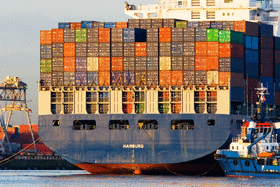Scheme Details
 To tackle the complex issue of GHG shipping emissions a new International Maritime Emissions Reduction Scheme (IMERS) is proposed.
To tackle the complex issue of GHG shipping emissions a new International Maritime Emissions Reduction Scheme (IMERS) is proposed.
The proposed scheme is global in order to maximise economic efficiency and avoid competitive issues of regional and national schemes. Specifically it is flag neutral. It is also differentiated as per the climate change regime and UNFCCC principles.
It addresses both emission mitigation and adaptation to climate change, including funding for transformational technology changes.
NOTE: The recent refund version, submitted at the Barcelona Climate Change Talks 2009" - is not fully reflected on these pages, yet.

Long-term Cooperative Agreement (LCA) for international shipping
The outcome of the scheme depends on the long-term cooperative agreement (LCA) for maritime contributions to the climate change action. Anticipated funding for the three goals together with the operational costs are shown in the table below for the LCA driven by a notional goal "20-50 from 2005 level" (reduce emissions 20% by 2020, and 50% by 2050 from the emission level in 2005). Carbon prices used: $30/tCO2 in 2012, $60/tCO2 in 2020. Emission baseline in 2005: 1GtCO2. Annual net emission growth: 2.1%/pa.
|
FUNDS per annum |
2012 |
2020 |
|
Technology |
$2bn |
$4.6bn |
|
Mitigation |
$4bn |
$15bn |
|
Adaptation |
$4bn |
$15bn |
|
Operational Costs |
$0.7bn |
$1.3bn |
- a working 1-page example

- a supporting document with main details
 (0.1 MB)
(0.1 MB)
Note that the recent estimates for emissions from shipping have doubled from a year ago!
Two historical summaries as prepared for the IMO MEPC 56 session in July 2007 are available:
Goals
The ambition is to Halve Maritime Emissions & Pay for Improvements needed in one cohesive supra-national scheme while addressing differentiated priorities from the developed and developing countries.

- The goals are:
- Mitigate the maritime GHG emission growth through the most cost effect measures and halve the emissions over long-term;
- Reduce the gap in financing for adaptation to climate change in developing countries (in $bn annually);
- Provide a global approach leading to agreement within the next 2 years.
The emission reductions will be achieved through near-term technical and operational industry improvements and by accelerating long-term step changes.
The scheme minimizes the administration burden and costs for ship owners, since it is a centralized system. It also avoids two major obstacles: unreliable emission baselines and allocation of emissions from international bunker fuel to countries.
Outline
 We propose that CO2 emissions from international maritime transport are treated on international level rather than being allocated to countries. An emission reduction goal (cap) is established and applies to all destinations with emission reduction commitments (currently Annex I countries). An emission charge is established. It is linked to the goal and the prevailing forward carbon price. Aggregated funds from the emission charges are used to both stimulate innovations and cost-effectively mitigate growth of maritime emissions. Furthermore, $billions of gains generated through the aggregated approach are directed to climate change adaptation in developing countries.
We propose that CO2 emissions from international maritime transport are treated on international level rather than being allocated to countries. An emission reduction goal (cap) is established and applies to all destinations with emission reduction commitments (currently Annex I countries). An emission charge is established. It is linked to the goal and the prevailing forward carbon price. Aggregated funds from the emission charges are used to both stimulate innovations and cost-effectively mitigate growth of maritime emissions. Furthermore, $billions of gains generated through the aggregated approach are directed to climate change adaptation in developing countries.
Global but Differentiated
The scheme is therefore both global (as per the IMO) and differentiated (as per the UNFCCC). It applies to all ships irrespective of flag and nationality, and fulfils the principle of common but differentiated responsibilities and respective capabilities. See the proposed Global but Differentiated principle.
Implementation
IMERS would implement a charge on the CO2 emissions from international shipping based on fuel use and cargo destination. Fuel data will be extracted from obligatory fuel receipts (called Bunker Delivery Notes). Alternatively, ship managers could report fuel use for voyages ended during the previous month. The emission charge (fee) would be announced at least one year in advance to allow passing on the charges to end customers. The fees would be paid by the fuel payers, typically charterers, typically monthly. The emission charges are differentiated as per the climate change regime in force, based on destination of cargo. Under the current regime, ships transporting goods to:
- Annex I countries pay 100% of emission charges
- Non-Annex I countries pay zero;
- Both types of countries pay on average 60% of emission charges (variable multiplier).
The liable entity is ship, and the scheme is enforced through port state control in Annex I countries.
Distribution of Funds
The charges raised would go to a supra-national fund established under the UN (under the IMO or the UNFCCC) and be used to:
- Invest in maritime technology transfer and stimulate longer term technology transformation;
- Purchase CO2 credits equal to the actual emissions in excess of the established emissions cap; and
- Contribute to climate change adaptation in developing countries.
Costs
A fee of US$9 per tonne of CO2 would bring about $6 billion annually from 2012 and raise shipping costs by circa 3% (to Annex I countries). This is equivalent to an extra $1 for every $1,000 of imported goods to Annex I countries. There is no impact on imports to non-Annex I countries.
The fee (a unit emission charge) is calculated in advance based on the prevailing forward carbon market price and a negotiated emission goal. This makes the proposed cap-and-charge an alternative to cap-and-trade, avoiding the barriers of emission trading (such as emission allocation and distribution of emission allowances).
Hybrid scheme: cap-and-charge
The scheme therefore is a hybrid one, both from the economics and goals points of view. It combines in a single scheme:
- a quantitative goal (cap) with a price instrument (charges): a “cap-and-charge”;
- emission mitigation, adaptation to climate change and technology action;
- differentiated responsibilities and capabilities, of countries and individuals.
The name does not really matter as long as the scheme can efficiently deliver the notional emission target (cap) at an affordable price ...
Not tax
The fee is not a levy or a tax set at some arbitrary level. The goal (cap) together with the market (via the market price for carbon) dictates the level of the fee, rather than a single body that may be subject to outside influence. The example $9 fee was calculated for 2012 assuming 2.1% rate of emission growth, emission goal of reducing emissions by fifth by 2020 from 2005 level, and a carbon market price of $30/tCO2.
Governance
Organisation: We propose establishing a multilateral Governing Organization (GO) within the UN system. The GO will be an execution organization with parameters provided for. It will be responsible for collection and disbursements services for international maritime CO2 emissions. The emission reduction goal and how the revenue is further divided will be decided by the Conference of Parties (COP). The emission charge will be set through a formula linking the emission reduction goal, emission growth and prevailing market price for carbon.
Adjustments to New Realities.
- Periodic governance mechanisms would allow for adjustment of charges and funding policy to new realities.
- Every 4-10 years the UNFCCC in consultation with the IMO should undertake a review and potential adjustment of the emission reduction goal, and the funding priorities (this may include relative size of the mitigation, adaptation and technology funds).
- Every year the body should undertake a market price review and setting of the new emission unit charge.
Administrative Procedures
 NOTE: 2007 version described. (improvements added in 2008 version)
NOTE: 2007 version described. (improvements added in 2008 version)
The description below is for the 2007 version. After recent consultation a simplified version is now preferred based around fuel delivered and the bunker delivery notes (BDN). BDNs are already required by the MARPOL Annex VI. The 2007 description has however an advantage of allowing to fully implement an IMO CO2 index. Furthermore, the 2008 Autumn version differentiates between Annex I and non-Annex I destinations to deliver on the UNFCCC principle of common but differentiated responsibilities (CBDR).
Data collection. We propose that ship managers submit a fuel used record to the scheme database for the recent voyages once a month, along with the volume of work and distance travelled for all ships under their management.
Monitoring and reporting. For monitoring and subsequent reporting the emissions are calculated by the scheme based on amount of voyage fuel used and type of vessel/engine, using appropriate emission factors (tier 2 methodology as per IPCC, 2006 Guidelines for National Greenhouse Gas Inventories).
Verification. Accounting and verification for the central organization will be subject to ISO 14064 standard for greenhouse gas accounting and verification. Electronic verification of fuel reports might be augmented in certain cases with the ship log verification by an authorised official at any port participating in the scheme.
Enforcement.
- It is proposed to enforce the compliance in selected ports for:
- Provision of relevant data for the most recent voyages;
- Payment of the emission charges for the period ending three months earlier (or similar).
Additional details are available in the presentation on IMERS data requirements
- They were discussed at the Technical workshop on Emissions from aviation and maritime transport, Oslo, Norway, 4-5 Oct 2007. The report and presentations from the workshop are available externally:
- workshop report by IISD
- workshop presentations
Synopsis
Practicability and Attractiveness
NOTE: Theses synopsis relate to the 1st generation of IMERS. The 3rd generation changes, including the rebate mechanism, are not reflected in the description below. These are provided for historical reasons.
The details of the scheme are provided below using two main criteria: Attractiveness and Practicability. Lessons learned have proved that successful schemes must combine policy appeal and economic efficiency with reliable data and feasible implementation. With some additional political will, the scheme can be operational even before 2012.
The mid-2007 IMERS synopsis, 1st generation ![]() (0.1 MB) used at the UNFCCC COP 13 in Bali meeting are included for comparison (note that the COP13 synopsis were based on the mid-2007 estimate of shipping emissions of around 0.5GtCO2; current estimates are double of that).
(0.1 MB) used at the UNFCCC COP 13 in Bali meeting are included for comparison (note that the COP13 synopsis were based on the mid-2007 estimate of shipping emissions of around 0.5GtCO2; current estimates are double of that).
Practicability
|
Scheme Design |
|
|
-- (None1; using the UNFCCC SBSTA option 1 – no allocation) |
|
-- (None needed) |
|
Fuel payers for charges; ship managers and/or suppliers for reporting |
|
Direct electronic; compliance enforced in selected ports, both for the provision of data (such as BDN) and payment of charges |
|
Implementation Feasibility |
|
|
Emission growth: available |
|
Fuel data, used or delivered: available (starting with Bunker Delivery Notes, BDN) |
|
Voyage data for validation; CO2 index from real data once the scheme operates, used as a performance measure for ships, routes etc. |
|
IMO for governance; World Bank, or similar, to manage adaptation funding (recommended Adaptation Fund under the UNFCCC) |
|
Scheme Parameters |
|
|
Yes; enclosed calculations done for notional reductions of 20% in 2020, and 50% in 2050 from 2005 level |
|
Baseline not needed, and avoided as it is currently commercially inadequate. |
|
Bubbles for containers, bulk, tankers, etc., could further improve the scheme equity and speed up implementation |
|
2 years – could be operational BEFORE 2012 |
Attractiveness
|
Scope and Goals |
|
|
Worldwide |
|
All vessels > 400 GT |
|
Global, or per vessel bubbles (containers, bulk, tankers, …) |
|
Adaptation to climate change in developing countries |
|
International, CO2 only at the beginning |
|
Political Appeal |
|
|
Through financing policy for adaptation; differentiation at point of distribution rather than collection |
|
None in sector; negligible outside shipping |
|
A hassle-free long-term solution, increased cash flow, compliance easily verifiable, long term investment clarity, better image of shipping |
|
Could be under MARPOL; IOPCF - a precedent for a direct fund; aviation route charges as an example of delegating collection and billing responsibility to a central organisation (Eurocontrol in Europe) |
|
Costs |
(for 2010, key assumed prices: fuel $500/tHFO, carbon $30/tCO2) |
|
Low: 0.1%, equivalent to adding $1 to price of $1,000 of imported goods |
|
Negligible (20 minutes reporting time for ship managers per month) |
|
$10/tCO2 or $30/tFuel (linked to emissions and carbon price) |
|
Under 5% (a centralized solution; operational ratio higher in the initial years) |
|
Effectiveness |
(assuming 1GtCO2 baseline in 2005; for others – multiply results by the respective baseline value in GtCO2 |
|
$4bn/pa; Total mitigation of 26 GtCO2 by 2050 (30% of it is emission avoidance) |
|
+0.5% annually, $2bn/pa Technology Fund, for transformational R&D and technology transfer |
|
$4bn/pa, for developing countries (likely as contribution to the UNFCCC Adaptation Fund) |
|
Only parties that legally support the scheme are eligible to participate in the scheme benefits (adaptation, technology and so on) |
|
Cost-effective through usage of carbon markets, and a dedicated maritime emission registry |
|
Flexibility |
|
|
CDM, CERs without limits; also programmatic CDM for increased quality |
|
Applies to both existing and new ships; no problems with including new entrants as scheme is based solely on charges, rather than allowances |
|
Charge annually; funding policy reviewed and adjusted periodically by IMO |
|
Can be limited to ship type or size threshold; easy scaling up thanks to the harmonized charge that does not vary with the number of participants |
1 The scheme avoids the complex problem of allocating emission allowances to countries, flags, routes or ships, and associated issues, such as lack of a reliable emission baseline, high transaction costs for small emitters etc. It achieves an emission cap on shipping emissions through a hybrid price-quantity mechanism that is linked to established emission markets, thereby delivering the reduction in the most cost effective manner.